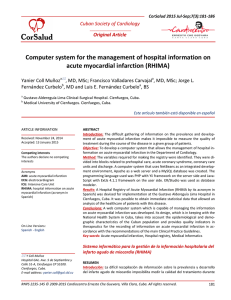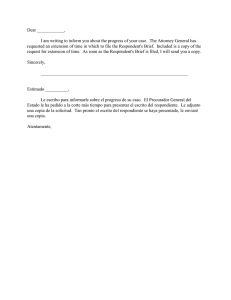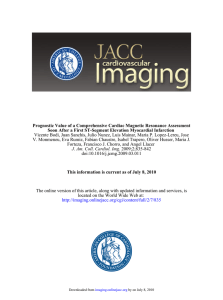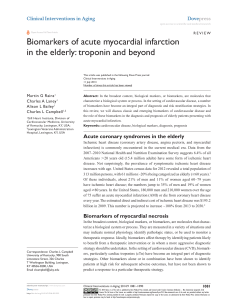Clinical features of patients who died from acute myocardial
Anuncio
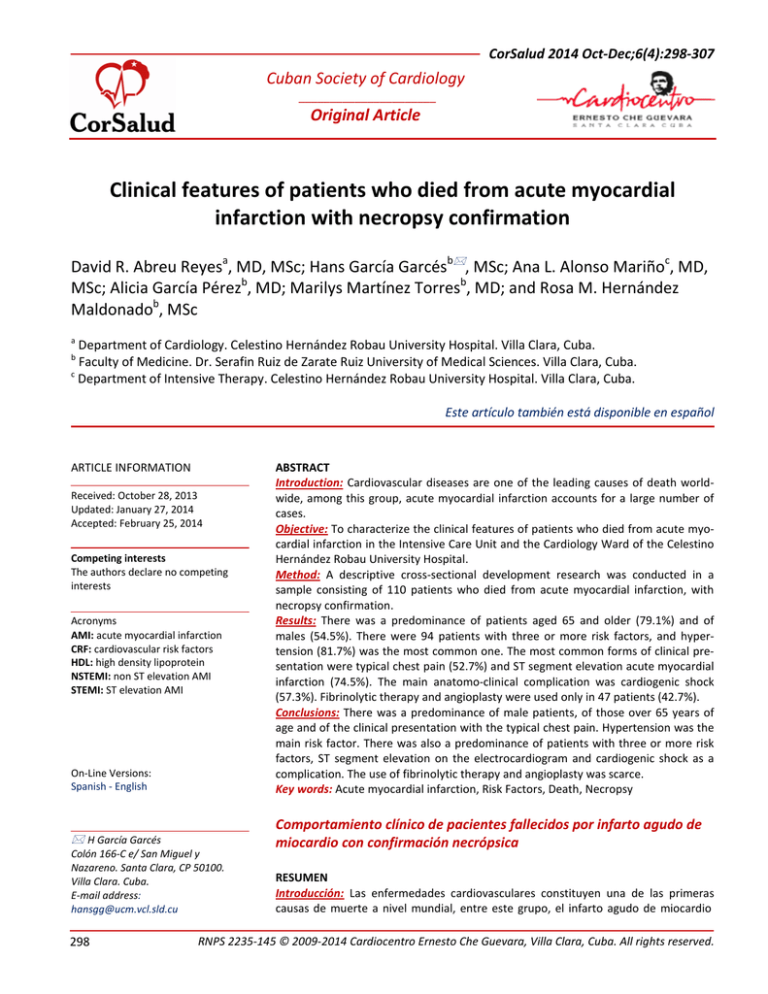
CorSalud 2014 Oct-Dec;6(4):298-307 Cuban Society of Cardiology ______________________ Original Article Clinical features of patients who died from acute myocardial infarction with necropsy confirmation David R. Abreu Reyesa, MD, MSc; Hans García Garcésb, MSc; Ana L. Alonso Mariñoc, MD, MSc; Alicia García Pérezb, MD; Marilys Martínez Torresb, MD; and Rosa M. Hernández Maldonadob, MSc a Department of Cardiology. Celestino Hernández Robau University Hospital. Villa Clara, Cuba. Faculty of Medicine. Dr. Serafin Ruiz de Zarate Ruiz University of Medical Sciences. Villa Clara, Cuba. c Department of Intensive Therapy. Celestino Hernández Robau University Hospital. Villa Clara, Cuba. b Este artículo también está disponible en español On-Line Versions: Spanish - English ABSTRACT Introduction: Cardiovascular diseases are one of the leading causes of death worldwide, among this group, acute myocardial infarction accounts for a large number of cases. Objective: To characterize the clinical features of patients who died from acute myocardial infarction in the Intensive Care Unit and the Cardiology Ward of the Celestino Hernández Robau University Hospital. Method: A descriptive cross-sectional development research was conducted in a sample consisting of 110 patients who died from acute myocardial infarction, with necropsy confirmation. Results: There was a predominance of patients aged 65 and older (79.1%) and of males (54.5%). There were 94 patients with three or more risk factors, and hypertension (81.7%) was the most common one. The most common forms of clinical presentation were typical chest pain (52.7%) and ST segment elevation acute myocardial infarction (74.5%). The main anatomo-clinical complication was cardiogenic shock (57.3%). Fibrinolytic therapy and angioplasty were used only in 47 patients (42.7%). Conclusions: There was a predominance of male patients, of those over 65 years of age and of the clinical presentation with the typical chest pain. Hypertension was the main risk factor. There was also a predominance of patients with three or more risk factors, ST segment elevation on the electrocardiogram and cardiogenic shock as a complication. The use of fibrinolytic therapy and angioplasty was scarce. Key words: Acute myocardial infarction, Risk Factors, Death, Necropsy H García Garcés Comportamiento clínico de pacientes fallecidos por infarto agudo de miocardio con confirmación necrópsica ARTICLE INFORMATION Received: October 28, 2013 Updated: January 27, 2014 Accepted: February 25, 2014 Competing interests The authors declare no competing interests Acronyms AMI: acute myocardial infarction CRF: cardiovascular risk factors HDL: high density lipoprotein NSTEMI: non ST elevation AMI STEMI: ST elevation AMI Colón 166-C e/ San Miguel y Nazareno. Santa Clara, CP 50100. Villa Clara. Cuba. E-mail address: hansgg@ucm.vcl.sld.cu 298 RESUMEN Introducción: Las enfermedades cardiovasculares constituyen una de las primeras causas de muerte a nivel mundial, entre este grupo, el infarto agudo de miocardio RNPS 2235-145 © 2009-2014 Cardiocentro Ernesto Che Guevara, Villa Clara, Cuba. All rights reserved. Abreu Reyes DR, et al. aporta un gran número de casos. Objetivo: Caracterizar el comportamiento clínico en los pacientes fallecidos por infarto agudo de miocardio en la Unidad de Cuidados Intensivos y en la Sala de Cardiología del Hospital Universitario “Celestino Hernández Robau”. Método: Se realizó una investigación de desarrollo, de tipo descriptivo transversal, en una muestra conformada por 110 pacientes fallecidos por infarto agudo de miocardio con confirmación necrópsica. Resultados: Predominó la edad de 65 años o más (79,1 %) y el sexo masculino (54,5 %). Hubo 94 pacientes con tres o más factores de riesgo, y la hipertensión arterial (81,7 %) fue la que predominó. Las formas de presentación clínica más frecuentes fueron el dolor precordial típico (52,7 %) y el infarto agudo de miocardio con elevación del segmento ST (74,5 %). La principal complicación anátomo-clínica fue el shock cardiogénico (57,3 %). El tratamiento fibrinolítico y la angioplastia se aplicaron solo a 47 pacientes (42,7 %). Conclusiones: Se observó un predominio del sexo masculino, de las edades superiores a 65 años, de la forma de presentación clínica con dolor precordial típico, y de la hipertensión arterial, como principal factor de riesgo; además, predominaron los pacientes con tres o más factores de riesgo, con elevación del segmento ST en el electrocardiograma y con shock cardiogénico como complicación. La administración de tratamiento fibrinolítico y la angioplastia fueron escasos. Palabras clave: Infarto agudo de miocardio, Factores de riesgo, Muerte, Necropsia INTRODUCTION Cardiovascular diseases have been found among the leading causes of death in many countries for several decades. Among these, coronary heart diseases are the predominant cause of morbidity and mortality in the Western world, and are considered a global epidemic as they have had a significant increase in developing countries1. However, in recent decades trends to reduce mortality from these diseases have been reported, nevertheless they represent a considerable health care burden2,3. The 2012 health statistical yearbook shows, regarding the causes of death, that heart diseases are relegated to a second place after malignant tumors in adults; however, the analysis of this indicator by age, shows that in those over 65 years heart disease is the leading cause of death. In 2012, the net death rate from this cause was 197.6 per 100,000 inhabitants. Acute myocardial infarction (AMI), presented a mortality rate of 56.7 per 100,000, and in 2011, 54.6, which shows an increase of 2.1%4. The province of Villa Clara, in particular, showed a net rate of heart diseases of 210.6 per 100,000 inhabitants in 20124, and in 2010, this rate was 197.85, which showed an increase of heart diseases. AMI is a common cardiovascular disease of uncertain progression, whose lethality during the acute phase, despite the many advances achieved, is very high, which justifies efforts and resources to improve its prognosis6-9. The severity of the condition and its prevalence may be related to cardiovascular risk factors (CRF), modifiable and non-modifiable, that influence the onset of coronary disease. Among the modifiable ones the following are described: dyslipidemia, diabetes mellitus, smoking and hypertension, as well as, with less importance, physical inactivity, emotional stress, personality and obesity10,11. Among non-modifiable RF previous history of ischemic heart disease at an early age, age and sex are described. Other CRF, recognized in recent decades, such as homocysteinemia have also been described12. Due to the different clinical presentations of AMI, the identification of patients with acute coronary syndrome is a challenge, especially in cases where there are no obvious symptoms or electrocardiographic findings, so the diagnosis of ischemic heart disease, and especially AMI is not always easy13-16; that is why serum cardiac markers with high sensitivity to myocardial damage have been developed17,18, allowing the diagnosis of AMI in patients who do not meet the classical electrocardiographic and clinical criteria19-21. The primary purpose of treatment for AMI is early recanalization of the infarct-related artery, that is why the immediate therapy of reperfusion, pharmacolo- CorSalud 2014 Oct-Dec;6(4):298-307 299 Clinical features of patients who died from acute myocardial infarction with necropsy confirmation gical (thrombolysis) or mechanical (angioplasty) is so important22. The objective of this research was to characterize the clinical behavior of patients who died of AMI, with necropsy confirmation in the Intensive Care Unit and the Cardiology ward, of Celestino Hernández Robau University Hospital. tables and graphs with their corresponding descriptive and inferential analysis. Frequency distribution tables with absolute (number of cases) and relative values (percentages) were created. The mean and mode was determined in the variables that required it for better presentation, as well as the standard deviation as a measure of variability. From the inferential point of view the difference in proportions test was applied in order to test if the percentage differences had a high statistical significance (p<0.05). METHOD A descriptive cross-sectional development research was conducted in the Intensive Care Unit and the Cardiology ward, of Celestino Hernández Robau University Hospital, in Santa Clara municipality, Villa Clara RESULTS province, Cuba, from January 1, 2008 until December Table 1 shows that patients generally died within 72.9 31, 2012. years; men in an interval ranging from 62 to 84 years, The study population consisted of all patients who with a mean age of 71.6 years; while for women the died during this period in the hospital with AMI age varied between 65 and 83 with a mean age of 74.4 criteria. The sample was selected using non-probabiliyears. The lowest age observed was 34 and the oldest ty sampling and consisted of 110 deceased. The in93. clusion criteria was: patients who died in the Intensive In general, more men than women died, 60 and 50, Care Unit and the Cardiology ward, to whom a pathorespectively. The most affected age group was 65 logic study was performed, which showed AMI as the years and over (87, 79.1%), although women show a cause of death. higher proportion in this group (43, 86.0%) than men The information was obtained from individual me(44, 73.3%). dical records, the autopsy reports of the Department High blood pressure (HBP) (81.8%), previous ischeof Pathology and deceased records of the Statistics mic heart disease (74.5%) and male sex (54.5%) were Department of the hospital. These documents prothe main CRF found (Table 2); followed, in order of vided the information necessary for the development frequency, by diabetes mellitus (45.5%), and obesity of the research, as it included general data of the was less frequent with only 11 patients (10,0 %). patient, features and clinical complications of AMI, The number and average of these CRF, according to and the behavior adopted in each case. age group are shown in Table 3. A total of 94 patients The information obtained was recorded in a data collection sheet that was created for that purpose. The following variables of interest were incluTable 1. Distribution of deceased patients by age and sex. Intensive Care Unit and Cardiology Ward. Celestino Hernández Robau Hospital, ded: age, sex, CRF, AMI presenta2008 - 2012. tion form, anatomic and clinical Sex complications, classification of Total Age groups Female Male AMI, according to electrocardio(years) Nº % Nº % Nº % graphic criteria, and reperfusion Less than 45 0 0 2 3,3 2 1,8 therapy. For statistical analysis, the in45 – 54 1 2,0 3 5,0 4 3,6 formation was organized in a 55 – 64 6 12,0 11 18,3 17 15,5 database, in Microsoft Excel; 65 and over 43 86,0 44 73,3 87 79,1 these data were exported to SPSS Total 50 100,0 60 100,0 110 100.0 (Statistical Packed for Social Sciences) version 15.0 for Windows, Mean ± SD 74,4 ± 9,1 71,6 ± 12,4 72,9 ± 11,1 where they were processed and p>0,05 Source: Data Collection Sheet the results were presented in 300 CorSalud 2014 Oct-Dec;6(4):298-307 Abreu Reyes DR, et al. It was found that 58 deceased (52.7%) had typical chest pain at admission, (Table 4). Other presentations forms were acute pulmonary edema (22.7%) and cardiac arrest (11.0%). Other less common symptoms were syncope (8.2%) and atypical chest pain (5.4%). Table 5 presents the anatomo-clinical complications present in AMI with (STEMI) and without ST elevation (NSTEMI). Cardiogenic shock was the most common complication for both types of AMI because Table 2. Risk factors present in deceased patients. it affected 63 patients (57.3%). Other complications Deceased CRF were conduction disorders (19.1%), the pump failure Nº % without shock (18.2%) and serious cardiac arrhythmias Hypertension 90 81,8 (17.3%), and less frequent were cardiac tamponade, Previous ischemic heart disease 82 74,5 occlusion stent and pulmonary embolism. The following are other complications with fewer numbers of Male sex 60 54,5 cases: pericarditis, postinfarction angina, mitral regurDiabetes mellitus 50 45,5 gitation, thrombus in the left ventricle, aneurysms and Smoking 36 32,7 pseudoaneurysms. Dyslipidemias 34 30,9 Table 5 also shows the distribution of patients regarding the elevation or non-elevation of ST segment. Family history of coronary 13 11,8 disease Of the total of cases in the study, 82 had ST segment elevation (74.5%) and 28 (25.5%), segment depression. Obesity 11 10,0 Of a total of 110 patients angioplasty was performed Table 3. Distribution of deceased patients by age and amount of CRF found. only in 10 (9.1%) Number of CRF Age groups and thrombolytic One Two Three or more Total Average (years) therapy in 37, reNº % Nº % Nº % Nº presenting 45.1% Less than 45 0 0 0 0 2 100 2 3,5 of the 82 that 45 – 54 0 0 0 0 4 100 4 5,8 might have re55 – 64 1 5,6 2 11,1 15 83,3 18 4,4 ceived it as they had STEMI (Table 65 and over 3 3,5 10 11,6 73 84,9 86 4,0 6). 45.9% of paTotal 4 3,6 12 10,9 94 85,4 110 4,2 tients received thrombolysis before 2 hours of Table 4. Clinical presentation forms of AMI in deceased symptom onset, 43.2% with a delay of more than 6 patients. hours, and 10.8% in the range between 2 and 6 hours. It is noteworthy that fibrinolytic therapy and angioClinical presentations Nº % plasty were only applied to 47 patients (42.7%). (85.4%) had three or more, whereas 12 (10.9%) had two, and only 4 patients (3.6%) had a single CRF associated with AMI. The highest number of cases with three or more factors is provided by the group aged 65 or older, with 73, and the highest average of CRF is present in the age group between 45 and 54 years, that has an average of 5,8 CRF per patient. Typical chest pain 58 52,7 Acute pulmonary edema 25 22,7 Cardiorespiratory arrest 12 11,0 Syncope 9 8,2 Atypical chest pain 6 5,4 Others 4 3,6 DISCUSSION AMI is a phenomenon observed more often in people over 60 years, although there has been an increase of acute episodes in younger individuals23. These results agree with Ramos et al.24 and Alvarez et al.25, who showed that this age group is most susceptible due to the impact, over the years, of atherogenic risk factors. CorSalud 2014 Oct-Dec;6(4):298-307 301 Clinical features of patients who died from acute myocardial infarction with necropsy confirmation Knowledge of CRF has allowed acting on their STEMI (n=82) NSTEMI (n=28) Total (n=110) Anatomo-clinical control and modification, complications Nº % Nº % Nº % which has a positive inCardiogenic Shock 50 61,0 13 46,4 63 57,3 fluence on primary and seConduction disorders 19 23,2 2 7,1 21 19,1 condary prevention of cardiovascular diseases. A stuPump failure (Killip class IV) 18 22,0 2 7,1 20 18,2 dy performed in Spain by Serious cardiac arrhythmia 16 19,5 3 10,7 19 17,3 Vázquez et al.30 in STEMI Cardiac tamponade 15 18,3 2 7,1 17 15,5 patients, shows hypertension (53.3%), smoking Stent occlusion 6 7,3 1 3,6 7 6,4 (44.7%), hyperlipidemia Pulmonary embolism 4 4,9 0 0,0 4 3,6 (38.2%) and diabetes melliOthers 3 3,6 0 0,0 3 2,7 tus (32.9%) as primary CRF. However, age, diabetes mellitus and previous is31 Table 6. Reperfusion treatment used in patients chemic events are linked to lethality to a greater who died due to AMI. extent; these results are similar to ours, where diabetes mellitus and a history of AMI ranked as frequent Treatment Nº % CRF in deceased patients. a Fibrinolytic 37 45,1 Apparently, the reduction of in-hospital mortality b < 2 hours 17 45,9 of patients with acute coronary syndromes has led to b 2 - 6 hours 4 10,8 an increased number of cases with chronic coronary b diseases that are likely to suffer new cardiovascular ≥ 6 hours 16 43,2 events. A 3-year follow-up of the REACH (Reduction of c PTCA 10 9,1 atherothrombosis for Continued Health) trial revealed d Primary 5 50,0 that all cardiovascular events increase from 25.5 to d 40.5%, and cardiovascular mortality increases from 4.7 Facilitated 1 10,0 d to 8.8% if more than one vascular region is affected32. Rescue 4 40,0 Smoking is considered the most worrying CRF in Caption. a: Percentage value based on the total of young patients with AMI, because it enhances the proSTEMI patients (82), b: values based on the total number of patients who received thrombolysis (37), c: percentages cess of atherogenesis by increasing the oxidation of based on the total number of patients in the study (110) , low-density lipoproteins and decreasing HDL-cholesd: values based on the total number of angioplasties terol, which makes the endothelium-dependent vasoperformed (14). dilation difficult and favors platelet aggregation and coronary spasm23,33. A Chilean study which assessed 1,168 patients with In turn, Alvarez et al.25 and Montalescot et al.26 NSTEMI, found that the highest impact CRF was hyperreport male sex predominance; however, other autension (49%), followed by dyslipidemia, smoking and thors have found female predominance27,28. Thus, it is diabetes mellitus34 and Ramos et al.24, in 2010, degenerally a disease that affects both men and women, tected in 177 patients, that the most frequent CRF a behavior more evident for ages over 50, when were hypertension (64.4%), smoking (53.7%) and hiswomen lose their estrogenic protection, as it has been tory of previous AMI (41.2%), which coincides with our suggested that estrogens increase serum levels of high results, except what was stated regarding smoking density lipoprotein (HDL), which reduces the risk of which was lower in our study, perhaps attributable to atherogenesis in women of childbearing age, so after the fact that smoking in our province is a phenomenon this phase the trend is to equalize the incidence of the that generally characterizes the younger population, disease in both sexes29. Therefore, male sex is conunderrepresented in the selected sample. sidered a risk factor for the occurrence of AMI in The least observed CRF are obesity and family hispatients younger than 60 years. Table 5. Distribution of deceased patients according to anatomo-clinical complications. 302 CorSalud 2014 Oct-Dec;6(4):298-307 Abreu Reyes DR, et al. tory, which is consistent with the literature reviewed 10-12,23,34 . Baena et al.35 in a study of 2,248 patients, found that 39.1% of cases did not present any CRF, 32.8% had only one associated factor and 17.5% had two; while 6.9% had three factors and only 3.7% from four to six CRF. These results are completely different from ours, where cases with three or more CRF predominated in all age groups. However, these same authors35 suggest that the number of CRF is directly proportional to the occurrence of any coronary disease and the risk is particularly high in subjects with more than three CRF. It is clear that the sample used in our research consisted of deceased with necropsy confirmation, so it is expected that due to the severity of the illness that triggered death, they presented several associated CRF. Data from observational studies have shown the limitations of anamnesis to identify patients with AMI. Indeed, about 25% of infarcts were not recognized in the first medical encounter, due to absence of pain or presence of atypical symptoms36-38. And Gutiérrez et al.39 in a research with geriatric patients found that the predominant symptom in a third of patients was pain. Other presentations were: dyspnea, mental confusion, acute pulmonary edema, hemiplegia and shock. As noted in our study, the typical pain was the predominant presentation form. Its prominence as chief complaint in emergency rooms justifies having protocols to optimize the available resources to minimize the risk of inappropriate discharge. Regarding complications, the highest percentage of patients with cardiogenic shock is attributed to the fact that our research was conducted in deceased, and shocks along with severe ventricular arrhythmias are the most lethal complications. According to Alvarez et al.25, in a study in Matanzas, they found that 12.4% of patients had conduction disorders, and 3.5% of the deceased had third-degree atrioventricular block. Ramos et al.24 found cardiac arrest, cardiogenic shock and arrhythmias as the most frequent complications. Rodriguez et al.27 who identified complications in deceased patients, found that the most common one was cardiogenic shock (41.8%), followed by serious cardiac arrhythmias (35.24%), acute pulmonary edema and the advanced atrioventricular block, both with 15.57%. Pump failure, with its most severe presentation, cardiogenic shock, currently holds the leading cause of in-hospital mortality, and death from this cause occurs primarily in the first three to four days of progression 14,17,40-43 . The results of this study agree with many others, where there is a predominance of STEMI; however, advances in noninvasive diagnostic techniques at the bedside have shown a significant increase of NSTEMI 18,44,45 . Santos et al.23 and Alvarez et al.25 found an incidence of STEMI of 69.3 and 70.33%, respectively, and Coll-Muñoz et al.44, in the province of Cienfuegos, obtained the result closest to ours (77.6%). The incidence of hospital admissions for STEMI varies from country to country; the most comprehensive registry of STEMI in the European region is probably the one made in Sweden, where the incidence is 66 per 100,000 inhabitants per year18. Similar data were collected in the Czech Republic, Belgium and the United States, where it has been found that STEMI incidence rates decreased between 1997 and 2005 from 121 to 77 deaths per 100,000 inhabitants, while NSTEMI incidence rates increased slightly from 126 to 132; which shows that the incidence of STEMI is declining, while there is a concomitant increase in the incidence of IAMSEST18. Reperfusion of AMI-related vessel is the treatment of choice and time is a determining factor. Ramos et al.24 found that 75.7% of patients arrived at the hospital within 6 hours of symptoms onset, 10.7% between 6 and 12 hours, and 9.6% between 12 and 24 hours. Coronary, pharmacological or mechanical reperfusion prevents many complications by achieving reduced infarct area, better healing and therefore less remodeling with reduced incidence of electrical and mechanical complications. Sherwood et al.46 reported a reduction in mortality when reperfusion is timely applied; they also state that in studies where thrombolysis was applied in the first 90 minutes after pain onset, mortality was only 1%; whereas, Bazart et al.47 found that from a total of 74 patients, only 12.2% received fibrinolytic therapy within the first two hours, 29.7% between the third and fourth hour, 18% between the fifth and sixth hour, and 33.7% received it more than six hours later. Delay times referred to in our research show that a considerable number of cases (35.5%) received fibrinolysis in times over six hours, something that is re- CorSalud 2014 Oct-Dec;6(4):298-307 303 Clinical features of patients who died from acute myocardial infarction with necropsy confirmation lated to lethality, because after that time the usefulness of this treatment is uncertain. Another factor that could lead to death is the limited number of patients who received fibrinolytic therapy in relation to the total of STEMI cases (45.1%), although our result is similar, or even superior to that found by other authors24,25,48. A European study found that of 4,035 STEMI patients, only 35% was treated with thrombolytic therapy. Greece, had the highest application rate of therapy with 52% and Lithuania the lowest rate, with only 13%. On average, 20% of eligible patients for therapy did not receive it49. PTCA rates worldwide are far superior to ours18,22, which was only performed in 12.7% of patients who died. Ramos et al.24 reported 26.6% of primary PTCA and Alvarez et al.25 used it in 60.94% of all cases. The low number of angioplasties performed is explained by several reasons: the study was performed on deceased, the time from symptoms onset to hospital arrival was prolonged, and in this province, the availability of percutaneous coronary intervention is limited to office hours. CONCLUSIONS The patients who died of AMI with necropsy confirmation were mostly male, over 65 years of age and with typical chest pain as presentation form. The most common CRF were hypertension and a history of ischemic heart disease; besides most of the deceased presented three or more CRF. STEMI and cardiogenic shock predominated. Thrombolytic therapy was administered to a small number of cases and PTCA was performed in a very small number of them. REFERENCES 1. Levi F, Chatenoud L, Bertuccio P, Lucchini F, Negri E, La Vecchia C. Mortality from cardiovascular and cerebrovascular diseases in Europe and other areas of the world: an update. Eur J Cardiovasc Prev Rehabil. 2009;16(3):333-50. 2. Orozco D, Cooper RS, Gil V, Bertomeu V, Pita S, Durazo R, et al. Tendencias en mortalidad por infarto de miocardio. Estudio comparativo entre España y Estados Unidos: 1990-2006. Rev Esp Cardiol. 2012; 65(12):1079-85. 3. Hamm CW, Bassand JP, Agewall S, Bax J, Boersma E, Bueno H, et al. Guía de práctica clínica de la ESC para el manejo del síndrome coronario agudo en 304 pacientes sin elevación persistente del segmento ST. Rev Esp Cardiol. 2013;65(2):172.e1-e57. 4. Dirección Nacional de Registros Médicos y Estadísticas de Salud. Anuario Estadístico de Salud 2010. La Habana: Ministerio de Salud Pública; 2011 [citado 12 feb 2012]. Disponible en: http://files.sld.cu/dne/files/2011/04/anuario-2010e-sin-graficos1.pdf 5. Dirección Nacional de Registros Médicos y Estadísticas de Salud. Anuario Estadístico de Salud 2011. La Habana: Ministerio de Salud Pública; 2011 [citado 12 feb 2012]. Disponible en: http://files.sld.cu/bvscuba/files/2012/05/anuario2011-e.pdf 6. Thygesen K, Alpert JS, Jaffe AS, Simoons ML, Chaitman BR, White HD. Documento de consenso de expertos. Tercera definición universal del infarto del miocardio. Rev Esp Cardiol. 2013;66(2):132.e1e15 7. Krumholz HM, Anderson JL, Bachelder BL, Fesmire FM, Fihn SD, Foody JM, et al. ACC/AHA 2008 performance measures for adults with ST-elevation and non-ST-elevation myocardial infarction: a report of the American College of Cardiology/American Heart Association Task Force on Performance Measures (Writing Committee to Develop Performance Measures for ST-Elevation and Non-STElevation Myocardial Infarction) Developed in Collaboration With the American Academy of Family Physicians and American College of Emergency Physicians Endorsed by the American Association of Cardiovascular and Pulmonary Rehabilitation, Society for Cardiovascular Angiography and Interventions, and Society of Hospital Medicine. J Am Coll Cardiol. 2008;52(24):2046-99. 8. Martínez C. Infarto agudo del miocardio no complicado. En: Caballero López A, ed. Terapia Intensiva. T II. La Habana: Ciencias Médicas, 2006; p. 795-809. 9. Del Pino E, Rodríguez V, Soto A, Abreu MR. Comportamiento del infarto agudo del miocardio en un centro médico de diagnóstico integral. Rev Cub Med Int Emerg [Internet]. 2008 [Citado 18 Abr 2013];7(4). Disponible en: http://bvs.sld.cu/revistas/mie/vol7_4_08/mie0940 8.htm 10.Anand SS, Islam S, Rosengren A, Franzosi MG, Steyn K, Yusufali AH, et al. Risk factors for myocardial infarction in women and men: insights from the INTERHEART study. Eur Heart J. 2008;29(7):932-40. CorSalud 2014 Oct-Dec;6(4):298-307 Abreu Reyes DR, et al. 11.Chávez LA. Principales factores de riesgo coronario en el anciano. Hospital General Camilo Cienfuegos de Sancti Spíritus. GME [Internet]. 2010 [citado 12 Oct 2013];12(3):[aprox. 2p.]. Disponible en: http://www.bvs.sld.cu/revistas/gme/pub/vol.12.% 283%29_07/p7.html 12.Campos C, Serra C. Factores de riesgo. En: Serra C, Salas J, Balestrini C, ed. Enfermedad coronaria en la mujer ¿dónde están las diferencias? Argentina: Instituto Modelo de Cardiología de Córdoba, 2009; p. 99-153. 13.Steg PG, James SK, Atar D, Bdano LP, BlömstromLundqvist C, Borger MA, et al. ESC Guidelines for the management of acute myocardial infarction in patients presenting with ST-segment elevation. Eur Heart J. 2012;33(20):2569:619. 14.Hernández S. Fisiopatología de los síndromes coronarios agudos. Arch Cardiol Mex. 2007;77(Supl 4): 219-24. 15.Van de Werf F, Bax J, Betriu A, Blömstrom-Lundqvist C, Crea F, Falk V, et al. Guías de Práctica Clínica de la Sociedad Europea de Cardiología (ESC). Manejo del infarto agudo de miocardio en pacientes con elevación persistente del segmento ST. Rev Esp Cardiol. 2009;62(3):e1-e47 16.Hamilton BH, Hollander JE. Diagnóstico del síndrome coronario agudo en los servicios de urgencias: mejoras durante la primera década del siglo XXI. Emergencias. 2010;22(4):293-300. 17.Antman EM. Infarto de miocardio con elevación del ST: anatomía patológica, fisiopatología y manifestaciones clínicas. En: Bonow RO, Mann DL, Zipes DP, Libby P, Braunwald E, ed. Braunwald Tratado de Cardiología: Texto de medicina cardiovascular. 9na ed. Barcelona: Elsevier; 2013. p. 1099 -122. 18.Grupo de Trabajo para el manejo del infarto agudo de miocardio con elevación del segmento ST de la Sociedad Europea de Cardiología (ESC). Guía de práctica clínica de la ESC para el manejo del infarto agudo de miocardio en pacientes con elevación del segmento ST. Rev Esp Cardiol. 2013;66(1):1-46. 19.León E, Pérez GA. Leucograma y glucemia en el pronóstico de pacientes con síndrome coronario agudo. Utilidad del índice leucoglucémico. CorSalud [Internet]. 2011 [citado 12 Oct 2013];3(2):93-102. Disponible en: http://www.corsalud.sld.cu/sumario/2011/v3n2a1 1/leucograma.htm 20.Quiroga W, Conci E, Zelaya F, Isa M, Pacheco G, Sala J, et al. Estratificación del riesgo en el infarto agudo de miocardio según el índice leucoglucémico. ¿El "Killip-Kimball" de laboratorio? Rev Fed Arg Cardiol. 2010;39(1):29-34. 21.Martín JL, Blanco LM, Tuñón J, Muñoz B, Madrigal J, Moreno JA, et al. Biomarcadores en la medicina cardiovascular. Rev Esp Cardiol. 2009;62(6):677-88. 22.Sánchez MG, Moreno-Martínez FL, Aladro IF, Vega LF, Ibargollín RS, Nodarse JR, et al. Valoración clínica y angiográfica de la reestenosis del stent coronario convencional. CorSalud [Internet]. 2014 [citado 14 Ene 2014];6(1):36-46. Disponible en: http://www.corsalud.sld.cu/sumario/2014/v6n1a1 4/reestenosis.html 23.Santos M, Valdivia E, Ojeda Y, Pupo AE. Factores de riesgo en el infarto agudo del miocardio en menores de 50 años en el Hospital Ernesto Guevara. Rev Cubana Cardiol Cir Cardiovasc [Internet]. 2012 [citado 12 Abr 2013];18(3):[aprox.2] Disponible en: http://www.revcardiologia.sld.cu/index.php/revcar diologia/article/view/200/280 24.Ramos B, González S, González I, Zorito BY, Llerena LD, Martínez PF, et al. Infarto miocárdico agudo, comportamiento de la terapia de repercusión en el servicio de emergencias. Rev Cubana Cardiol Cir Cardiovasc [Internet]. 2012 [citado 15 feb 2013]; 18(3):[aprox. 7]. Disponible en: http://www.revcardiologia.sld.cu/index.php/revcar diologia/article/view/119 25.Álvarez L, Santilel Y, Álvarez O. Manejo del Infarto Agudo de Miocardio en la Unidad de Cuidados Coronarios del Hospital Hermanos Ameijeiras 20062007. Rev Cubana Cardiol Cir Cardiovasc [Internet]. 2011 [citado 16 de abr 2012];17(2):[aprox.5]. Disponible en: http://www.revcardiologia.sld.cu/index.php/revcar diologia/article/view/52/35 26.Montalescot G, Dallongeville J, Van Belle E, Rouanet S, Baulac C, Degrandsart A, et al. STEMI and NSTEMI: are they so different? 1 year outcomes in acute myocardial infarction as defined by the ESC/ACC definition (the OPERA Registry). Eur Heart J. 2007;28(12):1409-17. 27.Rodríguez JA, Tamarit O, Adán A. Correlación clínico-patológica del infarto agudo del miocardio. Hospital Martín Chang Puga de Nuevitas. Rev Cubana Cardiol Cir Cardiovasc [Internet]. 2011 [citado 20 Mayo de 2012];17(3):[aprox.6.]. Disponible en: http://www.revcardiologia.sld.cu/index.php/revcar CorSalud 2014 Oct-Dec;6(4):298-307 305 Clinical features of patients who died from acute myocardial infarction with necropsy confirmation diologia/article/view/37/57 28.Bradshaw PJ, Ko DT, Newman AM, Donovan LR, Tu JV. Validity of the GRACE (Global Registry of Acute Coronary Events) acute coronary syndrome prediction model for six month post-discharge death in an independent data set. Heart. 2006;92(7):905-9. 29.Guallar P, Rodríguez F, Banegas J, Lafuente P, Del Rey J. La distribución geográfica de la razón varón/mujer de la mortalidad cardiovascular en España. Gaceta Sanit. 2011;15(4):296-302. 30.Vázquez E, Quesada E, Fajardo A, Torres J, Padilla M, Alania EM. Diferencia en la incidencia de hospitalizaciones por infarto agudo de miocardio con elevación de ST en los últimos 20 años. Rev Esp Cardiol. 2012;65(10):957-8. 31.Andrés E, Cordero A, Magán P, Alegría E, León S, Luengo E, et al. Mortalidad a largo plazo: un estudio de seguimiento. Rev Esp Cardiol. 2012;65(5): 414-20. 32.Alberts MJ, Bhatt DL, Mas JL, Ohman EM, Hirsch AT, Röther J, et al. Three-year follow-up and event rates in the international reduction of atherothrombosis for continued health registry. Eur Heart J. 2009;30(19):2318-26. 33.Amor A, Devesa C, Cuesta A, Carballo MC, Fernández A, García JC. La paradoja del tabaco en el síndrome coronario agudo sin elevación del ST. Med Clin (Barc). 2011;136(4):144-8. 34.Gabrielli LA, Castro PF, Verdejo HE, McNab PA, Llevaneras SA, Mardonez JM et al. Predictores de síndrome coronario agudo sin supradesnivel del ST y estratificación de riesgo en la unidad de dolor torácico. Experiencia en 1.168 pacientes. Rev Méd Chile. 2008;136(4):442-50. 35.Baena JM, Álvarez B, Piñol P, Martín P, Nicolau M, Altès A. Asociación entre la agrupación (clustering) de factores de riesgo cardiovascular y el riesgo de enfermedad cardiovascular. Rev Esp Salud Pública. 2002;76(1):7-15. 36.Kannel WB, Abbott RD. Incidence and prognosis of unrecognized myocardial infarction. N Engl J Med. 1984;311(18):1144-7. 37.Caballero E, del Valle JG, Pascual JR. Impacto de la trombólisis en pacientes con infarto agudo del miocardio en la Atención Primaria de Salud. MEDISAN [Internet]. 2011 [citado 20 Ago 2013];15(6):[aprox. 2p.]. Disponible en: http://scielo.sld.cu/scielo.php?pid=S102930192011000600012&script=sci_arttext&tlng=en 306 38.Herren KR, Mackway K. Emergency management of cardiac chest pain: a review. Emerg Med J. 2009; 18(1):6-10. 39.Gutiérrez JA, Hernández MA, González E. Presentación geriátrica del infarto agudo del miocardio. Rev Cuba Med. 1987;26(3):281-90. 40.Hurtado de Mendoza J, Álvarez R, Borrajero I. Discrepancias diagnósticas en las causas de muerte identificadas por autopsias. Cuba 1994-2003. Cuarta parte. Patología (México) 2010;48(1)3-7. 41.Hurtado de Mendoza J, Álvarez R. Situación de la autopsia en Cuba y el mundo. La necesidad de su mejor empleo. Patología (México). 2008;46(1):3-8. 42.Schoen FJ. El corazón. En: Cotran RS, Kumar V, Collins T, eds. Patología estructural y funcional. 6ta ed. Madrid: McGraw-Hill-Interamericana, 2000; p. 571-629. 43.Virmani R, Burke AP. Pathology of myocardial ischemia, infarction, reperfusion, and sudden death. En: Fuster V, Topol EJ, Nabel EG, eds. Atherothrombosis and Coronary Artery Disease. 2da ed. Philadelphia: Lippincott Williams & Wilkins; 2005. p. 805-24. 44.Coll Y, Ruíz J, Navarro J, de la Cruz L, Valladares F. Factores relacionados con la mortalidad intrahospitalaria en el infarto agudo del miocardio. Revista Finlay [Internet]. 2012.[citado 2013 May 17];2(3): [aprox. 8 p.]. Disponible en: http://www.revfinlay.sld.cu/index.php/finlay/articl e/view/133 45.Fox KA, Anderson FA, Goodman SG, Steg PG, Pieper K, Quill A, et al. Timecourse of events in acute coronary syndromes: implications for clinical practice from the GRACE registry. Nat Clin Pract Cardiovasc Med. 2008;5(9):580-9. 46.Sherwood MW, Morrow DA, Scirica BM, Jiang S, Bode C, Rifai N, et al. Early dynamic risk stratification with baseline troponin levels and 90minute ST-segment resolution to predict 30-day cardiovascular mortality in ST-segment elevation myocardial infarction: analysis from CLopidogrel as Adjunctive ReperfusIon TherapY (CLARITY)-Thrombolysis in Myocardial Infarction (TIMI) 28. Am Heart J. 2010;159(6):964-971.e1. 47.Bazart P, Correa M, Ramos LB, Lóriga O. Aplicación de estreptoquinasa recombinante en el IMA. Rev Ciencias Médicas [Internet] 2003.[citado 2005 mar 12];7(2):[aprox. 5p.]. Disponible en: http://publicaciones.pri.sld.cu/index.php/publicaci CorSalud 2014 Oct-Dec;6(4):298-307 Abreu Reyes DR, et al. ones/article/view/155 48.Leyva de la Torre C, Rego Hernández JJ. Causas de la no-trombólisis en el infarto agudo del miocardio y beneficios de su uso. Rev Cubana Farm [Internet] 2005(Mayo-Ago). [citado 18 mar 2008];39(2): [aprox. 7p.]. Disponible en: http://scielo.sld.cu/scielo.php?pid=S003475152005000200007&script=sci_arttext 49.Fox KA, Eagle KA, Gore JM, Steg PG, Anderson FA; GRACE and GRACE2 Investigators. The Global Registry of Acute Coronary Events, 1999 to 2009 GRACE. Heart. 2010;96(14):1095-101. CorSalud 2014 Oct-Dec;6(4):298-307 307
